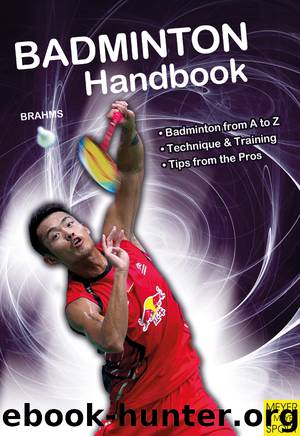Badminton Handbook by Bernd-Volker Brahms

Author:Bernd-Volker Brahms
Language: eng
Format: epub
ISBN: 9781782553540
Publisher: Bookwire GmbH
Published: 2010-08-20T16:00:00+00:00
16.5 Mental Training
The term mental training was coined in Sports Psychology and refers to the repeated visualization or mental practice of an action, without actively performing the action. The knowledge and methods have their origin in behavioral therapy and have been adapted to the requirements of sports psychology.
Fig. 119: The Dane Peter Gade has often suffered from nerves during his career.
Sports psychologists have been used in elite level badminton for just a few years. Players like the many-time Danish European Champion Peter Gade have turned to a psychologist after suffering from mental problems. The Dane was repeatedly considered to be the favorite in big tournaments, but was often affected by nerves. In critical game situations he bottled out, and was unable to play at his best. He wanted to call the opponent’s shots out and did not return the shuttlecock, even though he could have hit them. All too often they landed in the court though, allowing the opponent to score a few points. Gade tried to change this negative experience pattern by using mental training.
An improvement in the action in the conscious, intensive visualization should cause an improvement in the action when it is actually performed. The realized effect depends on how vividly the visualization succeeds, i.e. how successfully and realistically it simulates the action and how sensitive it is to the internal processes involved. This requires a constant switching between mental training and actual training, so that the action in the visualization can be repeatedly compared to the performed action.
It is essential that training not only engage the mind but also the body. Both must work in harmony so that their powers can be focused and deployed towards the same goal. This holistic approach is also reflected in the techniques that are used in mental training. Which techniques are used depends on various factors: the training emphasis, the coach’s method preference and the player’s starting situation and goals. It usually consists of a combination of:
• concentration and relaxation exercises
• autogenic training
• introduction to positive thinking
• meditation
• a guide to visualization
Fig. 120: Positive thinking is best reinforced by remembered successes. Here the English mixed doubles pair Nathan Robertson and Gail Emms celebrate their World Championships victory in 2006.
Download
This site does not store any files on its server. We only index and link to content provided by other sites. Please contact the content providers to delete copyright contents if any and email us, we'll remove relevant links or contents immediately.
Unstoppable by Maria Sharapova(3445)
Unstoppable: My Life So Far by Maria Sharapova(2425)
String Theory by David Foster Wallace(1394)
Open: An Autobiography by Andre Agassi(1290)
Zona by Geoff Dyer(1290)
Table Tennis Tactics for Thinkers by Larry Hodges(1253)
You Cannot Be Serious by John McEnroe(1244)
The Pub by Pete Brown(1207)
Rafa by Rafael Nadal & John Carlin(1174)
On Tennis by David Foster Wallace(1162)
Game On by Monica Seles(1156)
Getting a Grip by Monica Seles(1142)
Roger Federer by Chris Bowers(1141)
Everything You Know Is Pong by Roger Bennett(1075)
Play Better Tennis in Two Hours by Oscar Wegner & Steven Ferry(1072)
Table Tennis Tips by Hodges Larry(1071)
Ways of Grace by James Blake(1045)
Days of Grace by Arthur Ashe(1040)
Rod Laver by Rod Laver(1004)
